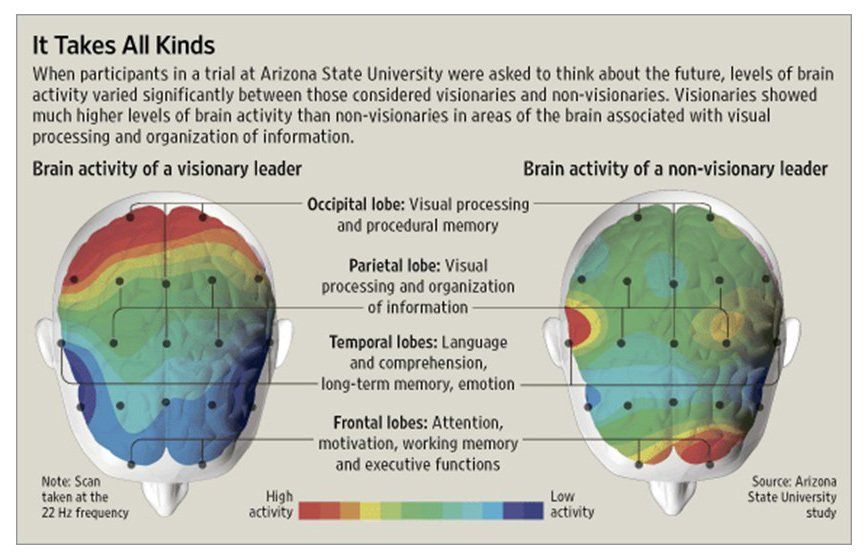Excerpts from:
This Is Your Brain on the Job
Neuroscientists Are Finding That Business Leaders Really May Think Differently
This Is Your Brain on the Job
Neuroscientists Are Finding That Business Leaders Really May Think Differently
By Phred Dvorak and Jaclyne Badal
Wall Street Journal: September 20, 2007 (Page B1)
GLENDALE, Ariz. -- How do you make a great leader? Pierre Balthazard starts by wiring electrodes to managers' scalps and recording electrical activity in their brains. After he completes 500 such scans, the Arizona State University management professor hopes the resulting data will enable him to plot a map of a leader's brain. Then, he wants to train ordinary brains to act like those of leaders.
Mr. Balthazard says the first 50 scans, of local luminaries, suggest that visionary leaders use their brains differently than others. In the past month, he added 20 Arizona State graduate students; next month, he's planning to scan 50 West Point cadets.
"We're coming up with the genome -- the brain map -- of the leader," says Mr. Balthazard from his ASU office, one littered with brain diagrams, plastic models and a windup toy brain with chattering teeth.

Mr. Balthazard is among a growing number of researchers looking inside the brain for business insights. The surge in interest among researchers is fueled by more powerful diagnostic tools and an improved understanding of how the brain influences character, personality and behavior.
Researchers have applied neuroscience to areas like economics, finance and marketing. Academics from Stanford University, Carnegie Mellon University and the Massachusetts Institute of Technology, for example, used a technique called functional magnetic resonance imaging to identify parts of the brain that influence buying decisions.
Mr. Thatcher says preliminary analysis of 50 brain maps shows some big differences in activity between managers who rate high on a psychological test of visionary leadership, and those who rate low. The visionary leaders had more efficient left brains, which deal with logic and reasoning, and better connected right brains, which are responsible for social skills.
Mr. Thatcher hopes to find more patterns as Mr. Fannin scans more brains. The patterns could indicate brain activity associated with specific qualities like charisma, or something common to all good leaders. The patterns could just reflect "faster brains -- more processing, more power," he says, adding that once the patterns are found, "you can move people" to them.
Mr. Balthazard is getting ready. He's seeking funding for hundreds more scans, and will brain-map West Point cadets this fall. He hopes to begin brain-training students as early as next year.
The school's marketing department has supplied Mr. Balthazard with small, rubber brains emblazoned with the Arizona State logo and the words: "Are you wired for leadership?"
Mr. Thatcher says preliminary analysis of 50 brain maps shows some big differences in activity between managers who rate high on a psychological test of visionary leadership, and those who rate low. The visionary leaders had more efficient left brains, which deal with logic and reasoning, and better connected right brains, which are responsible for social skills.
Mr. Thatcher hopes to find more patterns as Mr. Fannin scans more brains. The patterns could indicate brain activity associated with specific qualities like charisma, or something common to all good leaders. The patterns could just reflect "faster brains -- more processing, more power," he says, adding that once the patterns are found, "you can move people" to them.
Mr. Balthazard is getting ready. He's seeking funding for hundreds more scans, and will brain-map West Point cadets this fall. He hopes to begin brain-training students as early as next year.
The school's marketing department has supplied Mr. Balthazard with small, rubber brains emblazoned with the Arizona State logo and the words: "Are you wired for leadership?"
